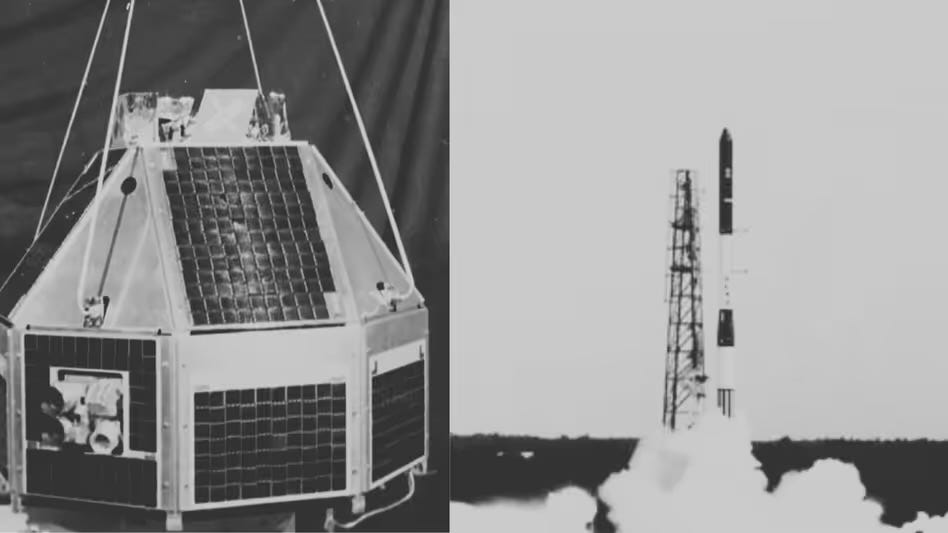How the First Satellite of India was built : APJ Abdul Kalam’s Role in India’s Space Journey with the Rohini Satellite
Aashi Jain, Grade 8, The Sky Explorers
(On the occasion of Dr. APJ Kalam’s birthday The Sky Explorers has invited students to write blogs on Dr Kalam’s life and work. This is the first blog of the student series.)
You would be shocked to know that India’s first satellite was launched in the 80’s! but what was the name of the satellite? did ISRO launch that satellite? who was the leader of the mission? And what were the obstacles faced by the scientists at that time? While the first Satellite launched was Aryabhatta, we used a Russian rocket to send it up in space. India’s first satellite that was built and launched in India was Rohini Satellite. Rohini is a series of satellite which was launched by the Indian Space Research Organisation (ISRO).
The Rohini series consisted of four satellites, each of which was launched by the Satellite Launch Vehicle (SLV) and three of which made it successfully to the orbit. The series were mostly experimental satellites. APJ Abdul Kalam was assigned as the Project Director of the SLV-III which launched Rohini Satellites. Now let us discuss about the obstacles faces by APJ Abdul Kalam and his team in the making of the first satellite of India.
APJ Abdul Kalam faced several obstacles while working on the Rohini satellite project :
1. Technological Limitations : At that time, India lacked advanced technology in satellite design and launch systems, requiring innovative solutions to overcome these limitations.
2. Resource Constraints : Limited funding and resources made it difficult to produce necessary materials and components, leading to delays.
3. Project Management : Coordinating various teams and ensuring effective communication among different departments was a significant challenge.
4. Testing and Reliability : Ensuring the reliability of the satellite and the launch vehicle required extensive testing, which was complicated by limited facilities.
5. Political and Bureaucratic Hurdles : Navigating the political landscapes and securing necessary approvals posed additional challenges.
6. Public Scepticism : There was scepticism about the feasibility of developing indigenous technology, requiring efforts to build public and governmental support.
Despite these obstacles, APJ Abdul Kalam’s leadership and vision were instrumental in successfully launching the Rohinisatellite in 1980, making a significant milestone for India’s space program. This also shows the positive attitude, the spirit of never giving up and believing in yourself of APJ Abdul Kalam, which we should appreciate and learn from him.
Let us discuss the contributions of APJ Abdul Kalam in the Rohini Satellite
APJ Abdul Kalam major contributions to the RohiniSatellite was as a project director for the developments of India’s first indigenous satellite launch vehicle (SLV-III):
1. July In 1980, the SLV-III successfully launched the Rohini satellite into near Earth orbit. This achievement made in India a member of the exclusive club of space exploring nations.
2. The SLV-III was developed in 1980, and parts of it were later incorporated into India’s first IRBM, Agni.
APJ Abdul Kalam’s other contributions to space technology include:
1. Being incharge of the evolution of ISRO’s launch vehicle program, specifically the PSLV (Polar Satellite Launch Vehicle) configuration.
2. He is also known as the ‘Missile Man of India’ for his contribution to developing India’s missile projects, the Prithvi and Agni missiles.
A Hopeful Future
The future of ISRO seems bright as it is planning a bunch of new missions like:
1. Venus Orbiter Mission (Shukrayaan)
2. Mars Orbiter Mission 2 (Mangalyaan 2)
3. Gaganyaan 3
Gaganyaan 3 is the first Human Spaceflight Mission of ISRO. Indian Space Research Organisation is also making a Next Generation Launch Vehicle or NGLV or “Soorya” which is a three-stage partially reusable Heavy-lift launch vehicle, currently under development.
It is surprising that how we started from carrying parts of rockets on bicycle and bullock cart to the launch site and launch it from a church on November 21, 1963 in Thumba, Kerla and now becoming the first country to reach mars in the first attempt itself. We should appreciate the sacrifices of ISRO scientists and all the people who have helped ISRO to become the sixth largest space agency in the world. We should also thank APJ Abdul Kalam and Vikram Sarabhai for setting the foundation of ISRO.



